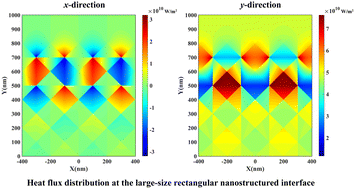Mechanisms for enhancing interfacial phonon thermal transport by large-size nanostructures
Abstract
Employing nanostructures has been experimentally demonstrated to be an effective way of enhancing the phonon thermal transport across solid–solid interfaces, whereas the strengthening mechanism by large-size nanostructures is still unclear. In this paper, a novel theoretical method for simulating the heat transfer characteristics of the solid–solid contact interface containing large-size nanostructures is developed by combining the lattice Boltzmann method and molecular dynamics. The phonon transport features of the planar interface and the nanostructured ones are compared. The effects of the nanostructure shape and size on the interfacial phonon thermal transport are investigated, and mechanisms for enhancing interfacial phonon thermal transport by large-size nanostructures are revealed. The results show that the phonon transport at the large-size nanostructured interface is distributed regionally and has a pronounced directionality. The thermal transport enhancement of the large-size nanostructured interface is primarily achieved by increasing the interfacial contact area with respect to the planar interface, which increases the probability of phonon scattering at the interface and forms a thermal conduction pathway. The interfacial thermal transfer enhancement of large-size nanostructures is also influenced by the interfacial shape and the ballistic transport effect. There exist the optimal shape and size of the nanostructures to maximize the thermal transport across the solid–solid contact interface.



 Please wait while we load your content...
Please wait while we load your content...